Vistas Lindas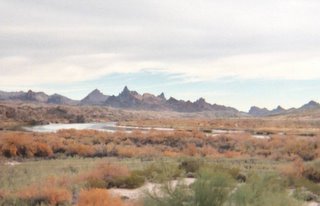
I had always thought that Needles, CA, was named after cactus needles, but apparently not: instead, it's these namesake peaks, located across the Colorado River in AZ, as seen here from Topock, AZ, that make for a pretty volcanic vista.
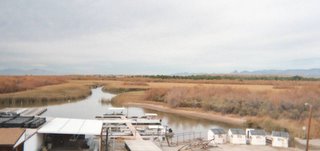
Here is another vista that greeted Oklahoma Dust Bowl refugees heading for California: the Colorado River Valley, as seen from the Topock marina. Cattail marshes like this are so rare in the desert SW as to be almost non-existent. Invasive, alien salt cedar is intruding into the marsh, and crowding out the welcome cattails. Salt cedar control is important along southwestern waterways - it's not impossible, but it does requires a lot of dedication and hard work.
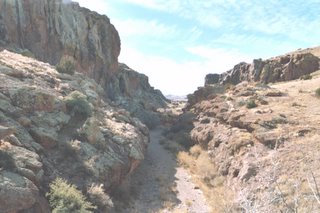
Box Canyon, as seen from Highway 60, a few miles SW of Socorro, NM.
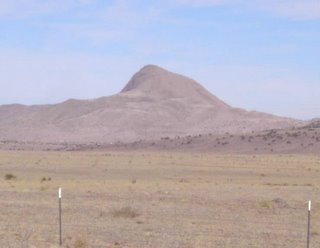
Strawberry Peak, as seen from Highway 60.
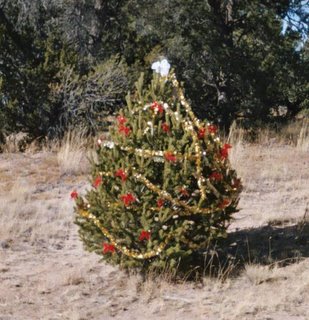
Random roadside holiday whimsy (between Magdalena NM, and the VLA).
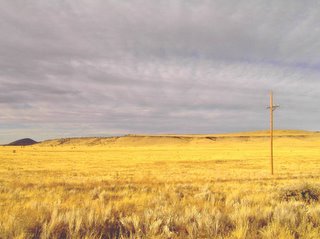
Beautiful sky and mesa, just east of Red Hill, NM.
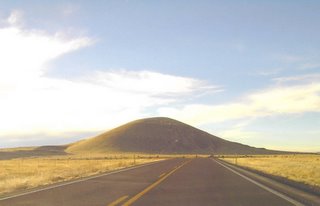
Volcanic cone of precise mathematical shape, along Highway 60, heading towards Show Low from Springerville, AZ.
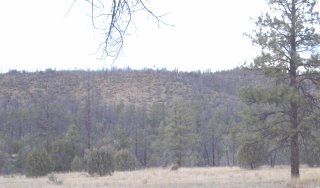
Eyeing mountain ridges on the other side of Corduroy Creek, near Carrizo, AZ, on the Fort Apache Indian Reservation, just a few miles SW of Show Low. I was surprised how little fire damage was evident: this entire area went up in flames just a few years ago. Apparently they succeeded in saving areas near the highway, though. Nevertheless, all the trees you see on the distant ridges are nothing but matchsticks - the fire burnt them all!
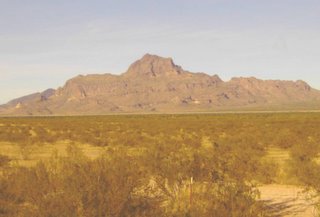
The Little Harquahala Mountains, Yuma County, AZ.
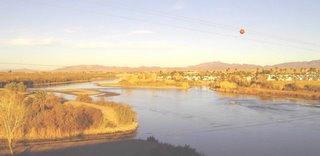
The Colorado River at the I-10 bridge, near Blythe, CA.

Dusk, looking north along the lower Colorado River Valley. Those may be the Whipple Mountains in the distance.

Mojave Desert side of the Tehachapi Mountains. The alluvial fan at the base of the mountains is truly remarkable. The alluvial fan appears to be hanging: it was abruptly elevated, and essentially severed, from the desert below. The Tehachapis are some of the most seismically-active mountains in the U.S., but this amount of fairly-recent mountain growth is truly astonishing!
 I had always thought that Needles, CA, was named after cactus needles, but apparently not: instead, it's these namesake peaks, located across the Colorado River in AZ, as seen here from Topock, AZ, that make for a pretty volcanic vista.
I had always thought that Needles, CA, was named after cactus needles, but apparently not: instead, it's these namesake peaks, located across the Colorado River in AZ, as seen here from Topock, AZ, that make for a pretty volcanic vista. Here is another vista that greeted Oklahoma Dust Bowl refugees heading for California: the Colorado River Valley, as seen from the Topock marina. Cattail marshes like this are so rare in the desert SW as to be almost non-existent. Invasive, alien salt cedar is intruding into the marsh, and crowding out the welcome cattails. Salt cedar control is important along southwestern waterways - it's not impossible, but it does requires a lot of dedication and hard work.
Here is another vista that greeted Oklahoma Dust Bowl refugees heading for California: the Colorado River Valley, as seen from the Topock marina. Cattail marshes like this are so rare in the desert SW as to be almost non-existent. Invasive, alien salt cedar is intruding into the marsh, and crowding out the welcome cattails. Salt cedar control is important along southwestern waterways - it's not impossible, but it does requires a lot of dedication and hard work. Box Canyon, as seen from Highway 60, a few miles SW of Socorro, NM.
Box Canyon, as seen from Highway 60, a few miles SW of Socorro, NM. Strawberry Peak, as seen from Highway 60.
Strawberry Peak, as seen from Highway 60. Random roadside holiday whimsy (between Magdalena NM, and the VLA).
Random roadside holiday whimsy (between Magdalena NM, and the VLA). Beautiful sky and mesa, just east of Red Hill, NM.
Beautiful sky and mesa, just east of Red Hill, NM. Volcanic cone of precise mathematical shape, along Highway 60, heading towards Show Low from Springerville, AZ.
Volcanic cone of precise mathematical shape, along Highway 60, heading towards Show Low from Springerville, AZ. Eyeing mountain ridges on the other side of Corduroy Creek, near Carrizo, AZ, on the Fort Apache Indian Reservation, just a few miles SW of Show Low. I was surprised how little fire damage was evident: this entire area went up in flames just a few years ago. Apparently they succeeded in saving areas near the highway, though. Nevertheless, all the trees you see on the distant ridges are nothing but matchsticks - the fire burnt them all!
Eyeing mountain ridges on the other side of Corduroy Creek, near Carrizo, AZ, on the Fort Apache Indian Reservation, just a few miles SW of Show Low. I was surprised how little fire damage was evident: this entire area went up in flames just a few years ago. Apparently they succeeded in saving areas near the highway, though. Nevertheless, all the trees you see on the distant ridges are nothing but matchsticks - the fire burnt them all! The Little Harquahala Mountains, Yuma County, AZ.
The Little Harquahala Mountains, Yuma County, AZ. The Colorado River at the I-10 bridge, near Blythe, CA.
The Colorado River at the I-10 bridge, near Blythe, CA. Dusk, looking north along the lower Colorado River Valley. Those may be the Whipple Mountains in the distance.
Dusk, looking north along the lower Colorado River Valley. Those may be the Whipple Mountains in the distance. Mojave Desert side of the Tehachapi Mountains. The alluvial fan at the base of the mountains is truly remarkable. The alluvial fan appears to be hanging: it was abruptly elevated, and essentially severed, from the desert below. The Tehachapis are some of the most seismically-active mountains in the U.S., but this amount of fairly-recent mountain growth is truly astonishing!
Mojave Desert side of the Tehachapi Mountains. The alluvial fan at the base of the mountains is truly remarkable. The alluvial fan appears to be hanging: it was abruptly elevated, and essentially severed, from the desert below. The Tehachapis are some of the most seismically-active mountains in the U.S., but this amount of fairly-recent mountain growth is truly astonishing!
No comments:
Post a Comment